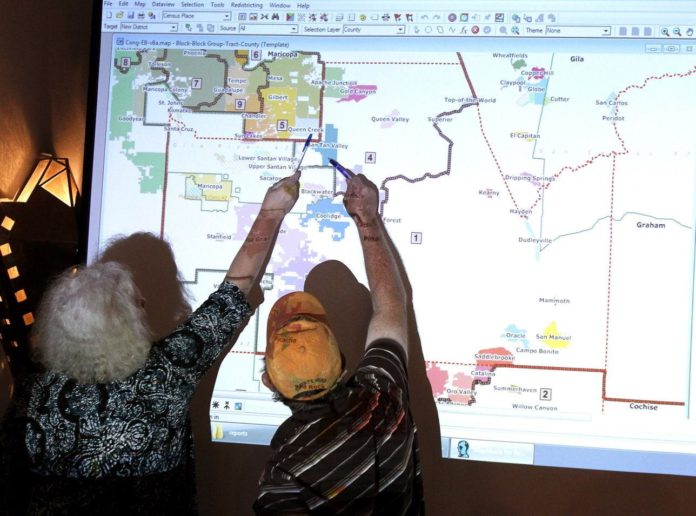
The state commission that will draw new congressional and legislative districts for use in elections during the coming decade is wrapping up a series of public hearings for Arizonans to provide input on how the districts should be drawn.
The 15 “listening tour” hearings, which began July 23 in Florence and will end Monday in Mesa, have focused on how the Independent Redistricting Commission should heed its constitutional duty to “respect communities of interest to the extent practicable.”
Many attending the hearings already conducted told the current commission where the speakers think the last one went wrong, the Arizona Capitol Times reported.
At one hearing, Tempe resident Tracey Ireland said her community that is now part of Legislative District 27 identifies more with neighboring Legislative District 18, which has comparatively fewer areas that are in the city of Phoenix.
“We have different school boards, different city councils, different everything except for legislative leadership,” Ireland said. “…The candidates are always going to be from South Phoenix; they’re never going to be from our community of interest.”
While turnout was “better than expected” for the first several hearings, commission Chair Erika Neuberg said during the commission’s July 27 regular meeting she was concerned about voices not heard.
“For example, people that are remarkably satisfied with their districts, they’re probably not showing up,” Neuberg said.
She suggested that the commission consider doing “more proactive work with soliciting information” from county supervisors, city council members, and others.
Mapping consultant Doug Johnson that people attending the hearings were unlikely to be those happy with current districts but said more input is expected once grid maps are drafted.
Grid maps are the precursors to draft maps that later evolve into final maps. The grid maps outline districts that are compact and have equal populations but don’t factor in other criteria. They are created with the goal to start the redistricting process from scratch, without regard to the current map.
“It’s a useful starting point. But it’s a starting point that is a bit of a mess, obviously, by design,” Johnson said.
In addition to aiming for compactness and equal population, commissioners are also supposed to create districts that respect communities of interest; comply with the U.S. and state constitutions and the federal Voting Rights Act; use visible geographic features, city, town and county boundaries, and undivided census tracts to draw lines; and are competitive.
Actual mapping will begin after the commission receives detailed 2020 U.S. Census population data this month. The commission has set a tentative timeline that calls for adopting grid maps by Sept. 14 and draft maps by Oct. 27, with time after each for public input. Commissioners hope to approve final maps by Dec. 22.
Once grid maps are adopted, the commission could hold another listening tour or just hear from the public at the commission’s weekly meetings or online, Johnson said.
He added that even if the commission doesn’t hear from a particular community, that doesn’t mean commissioners aren’t aware of it or won’t factor it into their maps.
Some groups are working to ensure more communities and their interests are heard.
Kendra Alvarez, All On The Line Arizona’s state director, said her organization is holding training sessions for people to attend ahead of the listening tour meetings. She said the sessions focus on teaching redistricting concepts so that people can advocate for their communities of interest effectively.
All On The Line is an anti-gerrymandering organization funded by the National Redistricting Action Fund, an affiliate of the National Democratic Redistricting Committee.
Alvarez said in addition to encouraging participation in the listening tour, her group will be watching how the commission builds on the public comment.
Fair Maps Arizona is also encouraging people to testify, providing an outline of what to include and telling people to send their drafts to the organization’s statewide director, Jay Wilson, who will “help you finish it up” and offer one-on-one assistance, according to the group’s website.
Fair Maps Arizona was founded by Republican Steve Gaynor, the Republican candidate in 2018 for Arizona secretary of state, to hold “Arizona’s elected leaders and the IRC accountable” during this year’s redistricting.
The commission is made up of two Democrats, two Republicans, and one independent, Neuberg.
The Independent Redistricting Commission was created by voters in 2000 to limit political influence by the Legislature in redrawing congressional and legislative district maps. The process is politically important because redrawn district lines can influence how many legislative and U.S. House seats each party can realistically win.
Republicans generally liked the district maps drawn after the 2000 Census, while those done following the 2010 Census were regarded as more favorable to Democrats, prompting strong criticism from Republicans.
The new maps should be in place for the 2022 elections.
Republished with the permission of the Associated Press.













